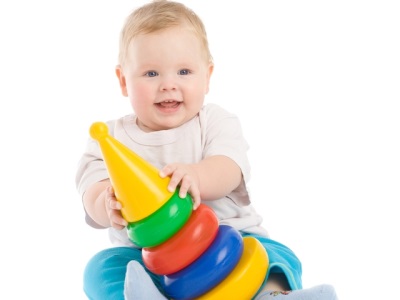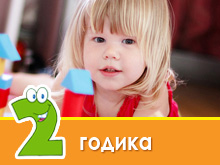Child development at 10 months
By his round date, the child had already learned a lot, began to show his individuality and independence. A ten-month-old tot is babbling and moving a lot. What else pleases parents of a crumb of this age and how to stimulate the development of an infant of 10 months?
Physiological changes
- Weight gain and an increase in other physical indicators at this age are no longer as active as in the first half of the year. This is due to the increased physical activity of the peanut.
- Coordination of movements of the child improves, which allows the baby to crawl quickly and move around the room. Fine motor skills also continue to develop. The kid learned to unclasp his fingers to throw an object, and also to take small objects only with his fingers.
- Many 10-month-old babies have already erupted 4 teeth, but if there are no teeth at all, this is not yet a reason for the experience.
Physical development
For the tenth month of life, the little goon gains about 450 grams and grows by 1-1.5 centimeters. Its chest circumference, as well as the head circumference, increases by an average of 0.5 cm.
Each child grows at his own pace, but there are norms, by consulting with which parents and doctors can determine if there are any serious deviations and whether it is necessary to examine the baby additionally. For each age category, both averages and boundary values are defined (exceeding them in any direction should be alerted). The main ones we presented in this table:
Indicator | Average value of 10 months | Boys in 10-11 months | Girls 10-11 months old |
Weight | 8500-9200 g | 7400-11400 g | 6700-10900 g |
Growth | 71.5-73.3 cm | 68.7-77.9 cm | 66.5-76.4 cm |
Head circumference | 44.2-45.4 cm | 42.9-47.9 cm | 41.5-46.9 cm |
Chest circumference | 47.2-47.9 cm | 45.1-51.4 cm | 45.2-50.1 cm |
The lessons on the “Little Leonardo” technique by Teplyakova O. N. - an expert in intellectual development will help the child to develop.
What baby can?
- A ten-month-old baby moves confidently and skillfully. The crumb is able to sit up from a standing and lying position, and also to stand up on feet, holding hands for support. In addition, at this age, many children go with support for durable furniture (step) or for both mother's hands. Some babies are already able to stand without any help, and also to walk without support.
- Scarce learned to walk up the stairs. The kid is able to overcome several steps both up and down the stairs.
- The movements of the hands of the child are already well coordinated. The kid performs various manipulations with toys, for example, opens and closes boxes, hides objects, rolls cars, builds turrets from several cubes. In addition, the child is able to flip through books with dense pages and tries to eat with a spoon.
- Small objects child does not have enough of the entire palm, and two fingers. Such a capture of objects called tweezers.
- In the child's speech there are various syllables and more and more often simple words start to come out of them. A child can name familiar objects in certain syllables. The child understands the speech of adults very well, repeating the movement upon request, for example, claps his hands or shows a part of the body.
You should consult a doctor if a crumb has not learned by the age of 10 months:
- Drop items from the table.
- Shake your head, showing agreement or denial.
- Wave your hand goodbye.
- Repeat the movement that shows an adult.
Classes for development
- Take time every day for gymnastics, performing exercises with your baby, which will help the baby to crawl and walk. Let the baby get up and crouch with your support, walk on all fours, bend and unbend the legs, lying on his back, and also walk, holding your hands.
- Since 10-month-old babies crawl a lot, give the baby space for movement. It is important that the house was clean and there were no dangerous items on the road.
- Train your baby to get off the couch. To do this, put the baby on the sofa, turn your booty to its edge and pull the legs down. Soon the toddler will understand how to get off, and will be able to do it confidently and quickly.
- Constantly communicate with the baby, at the same time utter short phrases and do not speak very quickly. Pronouns for the time being should be replaced with names, for example, “mother has a cube”, “Vanya takes a cube”.
- Invite a child to throw toys in a specific box. Kids in 10 months really like to do it.
- Continue classes, developing motor skills of the baby. Offer the crumbs to draw on a tray on which grits or flour are scattered, and also to dig in a bowl with beans or pasta. Let the child pour grain and beans from one container to another, untie the laces and ribbons, pour water.
- Give the child colored paper and show how to tear it into pieces.
- Play with clothespins - attach them to your child’s pants or blouse, and then teach them how to remove them.
- Hide the ticking clock under the pillow or blanket and wait for the child to find them.
- Engage with your baby with modeling (use salt dough) and drawing (try to paint with finger paints, small felt-tip pens, pencils, crayons). Blind together the sausage and the ball, color the picture.
- Offer the crumbs a few different jars with lids that unscrew. Let the baby open them and then close them.
- Daily some time to read. Well, if the crumbs have a separate shelf with children's books, and the baby will choose something to "read" on their own.
- On the street, teach your child to play with sand, using a spatula, various molds, a bucket, and rakes. In winter, these items can be used for playing with snow.
- Every day, turn on the music and dance together with the baby.
Care
Every day, the child is washed and washed, combed, brushed, planted in a pot, and bathed (mostly in the evening). As necessary, you need to clean the ears and nose karapuz, cut the baby marigolds.
Ten-month-old children continue to harden with the help of sunbathing, rubdowns, air baths, and bathing. Also at this age, you can pour the baby’s feet, gradually reducing the temperature of the water. It is only important not to forget that all procedures hardening should be systematic and gradual.
Daily regime
The sleep of a ten-month-old baby still lasts up to 15 hours a day. About 10 hours a child of this age sleeps at night, and in the daytime a child usually has two sleep, lasting 1-2 hours. Each child has its own biorhythm - some babies wake up at 6 am and fall asleep early for the night, others get up by 8-9 hours and fall asleep, respectively, at a later time.
It is advisable to walk with your child 2 times a day, staying at home only in very bad weather conditions (heavy rain, gusty wind, frost). In summer, a child can spend 5-6 hours outside. In good weather, give your child the opportunity to sleep during the day while walking, while leaving some time outside on the street and to be awake so that the child can observe nature, play with other children, walk with your support.
Diet in 10 months is represented by 5 meals, the intervals between which are approximately 4 hours. Babies who are breastfed receive human milk immediately after waking up and before bedtime.In total, a child of this age can be applied to the breast about 4-6 times for long feedings and as much for minute sucking. At night, babies wake up to suck their breasts 4-6 times, mostly from 3 to 8 am. Read more about this in the article about baby menu at 10 months.
Artificial children continue to give the mixture, suitable for age, in the first feeding, as well as before bedtime. Babies with any type of feeding eat complementary foods at 10 months in the same amount. At this age, fish are added to complementary food. In the second meal, the child usually eats porridge with butter, yolk and fruit. At lunch, the child is given vegetables, vegetable oil, meat, juice and bread, and in the afternoon snack (fourth feeding) - cottage cheese, fruits, cookies and kefir or yogurt.
Typical day
Every new day with a baby of ten months is filled with interesting moments. The organization of a particular daily regimen, taking into account the characteristics of the development and biorhythms of the child, is important for the nervous system of the child. Each child will have his own daily routine, but to understand how to build a regime, we offer an example of a day with a baby at 10 months:
6: 30 | Awakening. The first feeding, including, depending on the type of feeding, either breast milk or a mixture. |
7: 00 | Hygiene procedures. Period of wakefulness. |
9: 00 | Gymnastics. |
10: 00 | The second feeding, in which the baby is given porridge, fruit puree, butter and yolk. |
11: 00 | Walk, part of which takes the first sleep of the child in the fresh air. |
14: 00 | The third feeding, in which the child is usually given vegetables in the form of mashed potatoes or soup, meat (twice a week it is replaced with fish), vegetable oil, bread and fruit juice. |
14: 30 | Wakefulness period with educational games. |
16: 00 | Walk, during which the baby sleeps a second time in the fresh air. |
18: 00 | The fourth feeding, during which children are given fruit puree, cookies, cottage cheese and fermented milk drink. |
18: 30 | Wakefulness period with calm games. |
21: 30 | Bathing. |
22: 00 | The fifth feeding, in which the child, depending on the feeding, receives mother's milk or formula. Preparing for night sleep and laying down. |
Night time | Breast-fed infants are applied to mother's breast in a dream 4-6 times, and artificial-fed babies usually do not wake up for feeding. |
Frequent problems
- Allergic reaction to complementary foods. At 10 months, they begin to introduce a rather allergenic product - fish. It can cause a reaction in allergic-prone babies, so try fish very carefully. If, however, the introduction of such a product in the diet still has a reaction, the product is canceled and not given at least 1 year.
- Restless sleep. Many babies at 10 months of age can sleep poorly due to the large activity during the day and wake up due to loud noises, which is the norm. If the child shudders in a dream in the absence of harsh sounds, and also wakes up not in the mood, show the baby to a neurologist.
Tips for parents
- If your baby already has teeth, give him the opportunity to learn to chew hard food. Children of this age love to nibble drying, cookies, carrots. They should also be given pieces of boiled vegetables or fresh soft fruits (peach, banana).
- Begin to teach the crumbs to order. At the end of the day or after the game, put the toys together, making this process an interesting toddler. Also encourage your child to help around the house. A ten-month baby can already spread the napkins or wipe the dust with you. Be sure to praise the child and encourage such activities.
- Do not worry if the child is still not crawling. Some kids do not pass such a stage, but start walking at once.At the same time, do not rush the toddler, let him master walking independently.
- During the walk, go to the playground so that the baby can watch the other kids play and socialize.
- Do not scold the child if he breaks toys or throws them. So he explores different subjects and this behavior is the norm for a 10-month-old baby.
For the development of the child's muzakalnogo development spend with a crumb classes, shown in the video Lazarev M. L.
































